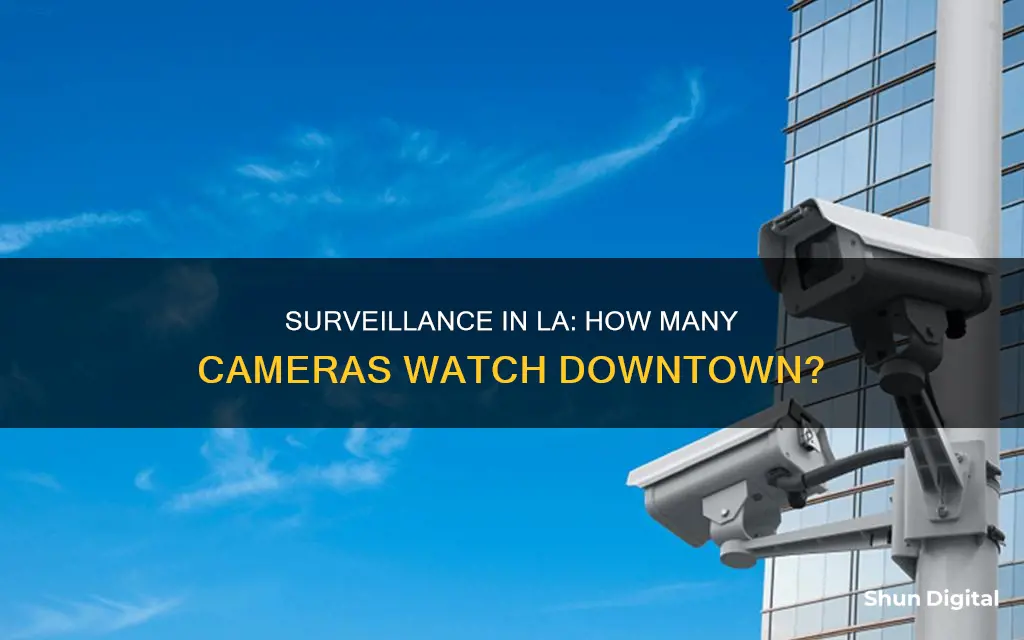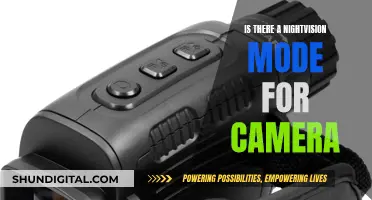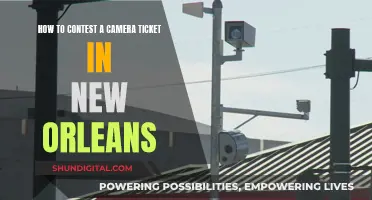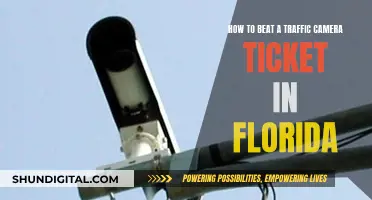
The number of government-run surveillance cameras in downtown Los Angeles is a topic of debate and concern for civil liberties advocates. While the exact number of cameras in downtown LA is unclear, Los Angeles is among the most surveilled cities in the US and worldwide. The LAPD's planned LAPD Live program aims to centralize live video feeds from 10,000 security cameras, including private homeowner cameras, across the city. This has sparked discussions about the balance between public safety and privacy rights, with critics arguing that increased surveillance may lead to government intrusion and abuse of power.
What You'll Learn

The LAPD wants access to 10,000 cameras
The Los Angeles Police Department (LAPD) has plans to develop a new surveillance program that will give them access to 10,000 cameras across the City of Los Angeles. The program, called LAPD Live, will centralize live video feeds from security cameras in public and private spaces, including those on city buildings, retail stores, police body cameras, and the department's helicopters. Homeowners will also have the option to register their own security cameras with the department to share footage and be notified if a crime is committed nearby.
The LAPD argues that this program will increase "community participation" and reduce the time and money spent on investigating crimes, gathering evidence, and talking to witnesses. They claim that it will "eliminate the need for officer visits to private residents," which will "preserve individual privacy." In addition, the LAPD says that the real-time crime center will be a force multiplier, providing them with real-time information to help dedicate their finite resources more efficiently. With global events such as the 2026 World Cup and 2028 Olympics coming up in Los Angeles, the LAPD intends to have the program fully operational to ensure the safety and security of the public.
However, there are concerns about the potential invasion of privacy and the possibility of more racial profiling, with critics arguing that this technology will cause more harm to communities already impacted by the department. In addition, the effectiveness of the program in combating crime, especially violent crime, is uncertain. While the LAPD has stated that the program will help reduce shoplifting crimes, data shows that the commercial shoplifting rate in California has actually decreased by 10% between 2015 and 2022.
The $1 million budget request for the program is part of the LAPD's overall $239 million budget increase, which has been approved by the Board of Police Commissioners for the 2024-2025 fiscal year. If the LA City Council and Mayor Karen Bass also approve the budget increase, the department plans to pilot the surveillance program in three patrol areas before implementing it in all 21 of LAPD's community police stations and four major patrol bureaus. The full rollout of the surveillance program is estimated to be completed by 2027.
This development adds to the growing debate over the use of surveillance cameras in public spaces and the potential infringement on citizens' constitutional right to privacy. While some argue that it improves law enforcement and crime prevention, others worry about the increased likelihood of government abuse and the impact on civil liberties. As the rollout of the program progresses, it is essential to consider these concerns and strike a balance between public safety and individual privacy rights.
The Rebel T6 Camera Battery: How Long Does It Last?
You may want to see also

The debate over surveillance cameras in LA
The debate over the use of surveillance cameras in Los Angeles and other cities is a complex issue that involves weighing the benefits of increased security and crime deterrence against potential drawbacks, such as invasions of privacy and the risk of abuse.
On the one hand, proponents of surveillance cameras argue that they are an effective tool for fighting crime and enhancing public safety. They suggest that cameras can help deter crimes such as property and vehicle crimes in parking lots and provide valuable evidence to aid in criminal investigations. Additionally, real-time monitoring of public spaces can enable a faster response from law enforcement to potential threats or volatile situations. This was demonstrated by the city of Oakland, California, which decided to implement surveillance cameras in 1997.
On the other hand, critics of surveillance cameras raise important concerns about the potential negative consequences of their use. One of the primary arguments against surveillance cameras is that they infringe on citizens' constitutional right to privacy. The presence of cameras in public spaces can create a sense of constant monitoring, making individuals feel uncomfortable and intruded upon. This sense of being watched can lead to a chilling effect, causing people to alter their behaviour to avoid scrutiny and potentially impacting their right to free expression.
Additionally, there are worries about the potential for abuse of surveillance footage. Without clear limits and regulations on the use of public cameras, there is a risk of misuse by law enforcement or other entities. This could include voyeurism, blackmail, or invasion of private spaces. The high cost of installing and maintaining surveillance systems is also a significant consideration, especially when weighing the potential benefits against the financial burden.
Traffic Monitoring: Camera Tickets for Vehicles?
You may want to see also

LA is one of the most surveilled cities in the world
Los Angeles is one of the most surveilled cities in the world, with a vast network of government-run and private surveillance cameras covering its streets. While the exact number of government-run cameras in downtown LA is unclear, estimates suggest that the city as a whole has a large number of cameras monitoring its residents and visitors.
According to a 2022 report by the Los Angeles Times, the city of Los Angeles has approximately 35,000 surveillance cameras, serving a population of about 4 million people. This equates to roughly 9 cameras for every 1,000 residents, a ratio that places LA among the most surveilled cities globally.
The presence of surveillance cameras in LA has been a topic of debate, with some arguing that they improve safety and help deter and solve crimes, while others raise concerns about privacy and government intrusion. Civil liberties organisations like the American Civil Liberties Union (ACLU) have warned that the increased use of cameras could lead to abuse by government officials and a slippery slope when it comes to surveillance.
In recent years, the Los Angeles Police Department (LAPD) has sought to expand its access to surveillance cameras even further. In 2023, the LAPD proposed a new surveillance program called "LAPD Live," which would give the department real-time access to 10,000 security cameras across the city, including private homeowner cameras and cameras on city buildings, retail stores, police helicopters, and officer body cameras. The program has faced opposition from privacy advocates and community organisations, who argue that it could lead to more racial profiling and cause harm to communities already impacted by police surveillance.
Despite the concerns, the LAPD's budget request for the program, totalling $1 million, was approved by the Board of Police Commissioners, and it is now awaiting approval from the LA City Council and Mayor.
Beyond the government-run cameras, LA is also home to a significant number of private surveillance cameras. A 2024 study by Comparitech found that Los Angeles had approximately 10,669 Dahua/Hikvision camera networks, which are used by private individuals and businesses for security purposes.
With its extensive network of government-run and private cameras, LA joins other cities around the world that have come under scrutiny for their heavy surveillance tactics, including several Indian and Russian cities, Seoul, Singapore, London, and New York.
Camera Tickets: Legal in Miami-Dade County?
You may want to see also

The effectiveness of CCTV in crime prevention
The Benefits of CCTV
Closed-circuit television (CCTV) is a video surveillance technology that has been increasingly adopted worldwide. CCTV cameras are used to monitor specific areas and can be an effective tool for crime prevention and evidence collection. They are often installed in places such as banks, supermarkets, casinos, airports, military institutions, and convenience stores.
CCTV can act as a deterrent, reducing the likelihood of criminal activity in the monitored areas. According to research, CCTV has proven to be particularly effective in reducing crime in car parks, with a significant decrease of up to 51% in some cases. It is also more effective when combined with improved street lighting and targeted at vehicle-related crimes.
CCTV also assists in tracking criminals and providing evidence for investigations. The availability of video footage makes it easier to identify and convict perpetrators, addressing the challenges of proving crimes and ensuring that criminals are brought to justice.
The Limitations of CCTV
While CCTV has its benefits, there are also factors that limit its effectiveness in crime prevention. One of the main concerns is the potential invasion of privacy. The extensive use of CCTV may raise the likelihood of government abuse and infringe on citizens' constitutional rights to privacy, as seen in the debate over surveillance cameras on LA streets.
Additionally, the effectiveness of CCTV may vary depending on the location and the type of crime. Research suggests that CCTV is more effective in certain countries, such as the UK, compared to North America. It is also less effective in reducing violent crimes and is more successful when combined with other interventions, such as increased police presence.
Furthermore, the mere presence of CCTV may not always deter crime. Criminals may become accustomed to the cameras and find ways to avoid detection, or simply choose different targets or locations.
The Future of CCTV in Crime Prevention
Despite the limitations, CCTV continues to be a valuable tool in crime prevention and reduction. However, it should be used strategically and in conjunction with other measures to enhance its impact. The development of smart CCTV systems, integrated with technologies like AI, can further optimise their effectiveness and reduce the risk of human error.
In conclusion, while CCTV has its advantages and can be a successful crime prevention tool, it should be used carefully and responsibly, addressing privacy concerns and complemented by other interventions to maximise its benefits.
Portait Mode on Galaxy S7 Edge: Where and How?
You may want to see also

The potential for government intrusion and abuse
While the LAPD argues that this program will increase community participation and preserve individual privacy by reducing the need for officer visits to private residences, there are valid concerns about the potential for abuse and misuse of this extensive surveillance system. In the past, the LAPD has come under fire for its collaboration with Ring, a company that provides home security products and services. The partnership, called "Neighbors", allowed the police department to access footage from Ring camera owners, including during the Black Lives Matter protests. This collaboration raised concerns about the fine line between community participation and intrusion, as users may have unknowingly shared their footage with the police.
As the number of government-run surveillance cameras continues to grow, it is essential to consider the potential consequences of misuse or abuse of this technology. While the primary goal of these surveillance programs is to improve public safety and combat crime, there is a delicate balance between security and individual privacy. Without proper safeguards and accountability measures in place, the potential for government intrusion and abuse of power increases, potentially leading to a violation of civil liberties and a negative impact on communities.
To conclude, while the government's efforts to enhance public safety through surveillance programs like LAPD Live are understandable, it is crucial to address the concerns regarding potential intrusion and abuse. Striking a balance between security and privacy requires careful consideration of guidelines, oversight, and community involvement. By fostering an open dialogue and implementing robust safeguards, the potential benefits of surveillance technology can be realized while mitigating the risks of government intrusion and abuse.
Outdoor Surveillance Cameras: Wireless, but Power-Hungry?
You may want to see also
Frequently asked questions
There are approximately 39,790 government-run surveillance cameras in Los Angeles, which equates to about 10 cameras per 1,000 people.
Surveillance cameras are used for a range of purposes, including monitoring traffic, crime prevention, and observing industrial operations.
Yes, there are concerns about the potential invasion of privacy and government intrusion into people's lives. There are also worries about the potential for abuse by government officials and biased use by law enforcement.
Proponents of surveillance cameras argue that they can improve public safety, deter crime, and assist in solving crimes. They can also provide valuable evidence for criminal investigations and prosecutions.







